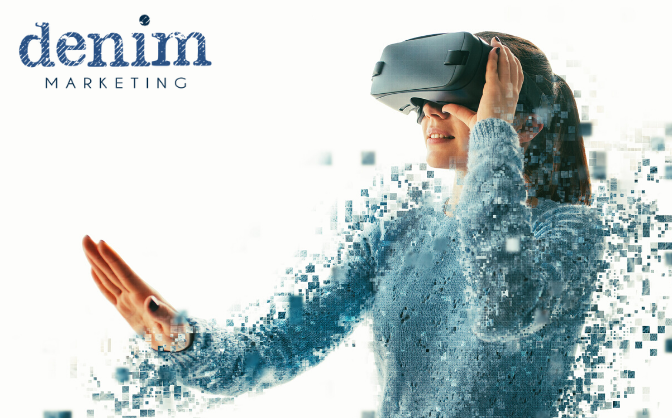 Augmented reality (AR) and virtual reality (VR) are two huge buzz words flying around the tech and social media industry. In the past, users logged onto desktops computers to access Facebook and other social platforms. As mobile devices and smartphones became widely available, technology and social media shifted to mobile-first applications. Now, a new wave in social media is emerging through the use of augmented and virtual reality features. These new features are already in practice by businesses, brands and developers and is transforming social media into a more interactive, immersive and visual tool.
Augmented reality (AR) and virtual reality (VR) are two huge buzz words flying around the tech and social media industry. In the past, users logged onto desktops computers to access Facebook and other social platforms. As mobile devices and smartphones became widely available, technology and social media shifted to mobile-first applications. Now, a new wave in social media is emerging through the use of augmented and virtual reality features. These new features are already in practice by businesses, brands and developers and is transforming social media into a more interactive, immersive and visual tool.
What is it?
While AR and VR share certain similarities, they are both very different technologies that offer very different user experiences. Augmented reality takes a live view of the real world, typically through a smartphone or mobile device, and places digital overlays on top of them. Most people are familiar with AR technologies through Snapchat and Instagram’s popular interactive lenses and filters.
While augmented reality combines the live world with digital components, virtual reality offers users a full immersion experience. In VR, the physical world is removed, and users are transported into a real or imagined 3D environment. Through virtual reality, users can walk with dinosaurs, go on a wild African safari or transport themselves to a futuristic landscape. More immersive VR experiences require headset devices such as Oculus VR or Google Cardboard, while others can simply be viewed through interactive 360 or 3D videos.
Incorporating AR and VR into Your Social Media Strategy
While many simply see AR and VR as a fun tool for photo apps and smartphone games, these two emerging technologies show incredible potential in numerous industries such as healthcare, education, manufacturing and more. However, AR and VR are finding the most success in the same industry they gained their popularity- social media. Incorporating these current AR and VR tools can help businesses to stay ahead of the game when it comes to increasing brand awareness and engagement.
- Interactive Lenses: One of the most well-known uses for AR on social media is through the use of interactive filters or lenses. Since releasing augmented reality features on the app, Snapchat has added even more opportunities for users to explore AR. Interactive AR games are allowing users to connect and shoppable AR lenses give users the opportunity to virtually try and shop for products like sunglasses or lipstick all through their camera lens. In addition to Snapchat, other platforms such as Instagram and Facebook are also shifting their focus to AR features and now have their own versions of interactive lenses for social, gaming and retail purposes. Facebook launched and app, Spark AR Studio, that serves as a platform for developers to create unique augmented reality effects.
- 360 and 3D Videos- Thanks to new VR technology, businesses can now incorporate virtual features on their websites and social media in the form of 360 videos. Facebook is already providing a more immersive experience for users with interactive tools such as Facebook 360 videos that encourage users to explore from all angles. Other popular VR video tools include Matterport 3D virtual tours which are already redefining the real estate industry by allowing consumers to virtually walk through a listed property without physically having to step foot inside of it.
What’s Next for AR and VR?
AR and VR are such new technologies with such amazing potential for success in social media. As technology continues to advance, these powerful reality-altering tools will become integrated even more into our everyday lives. AR will continue to be an important tool for businesses to build brand awareness and connect to consumers through more engaging experiences.
As technology becomes more accessible, complete VR applications involving headsets and equipment may even take over social media platforms and change the way users view content. (However, a huge majority of the population experiences motion sickness when using these types of headset, so they are going to need to improve before they become mainstream.) More businesses and brands are recognizing the potential of fully immersive experiences and testing virtual simulations that allow consumers to interact with and test products. Plus, with Facebook’s acquisition of Oculus VR, the possibilities for VR opportunities are endless. According to Oculus, it’s new Facebook-powered features such as chats, multi-person gatherings and content sharing is already connecting the two apps and setting them up for further expansion.
Incorporating AR and VR content in your social media strategy is a win-win for businesses and consumers. Customers will enjoy getting involved and immersed in the technology which will result in an increase of brand awareness and engagement with businesses.
Looking to keep up with this new wave of social media? Let us help you to incorporate AR and VR features into your social media marketing strategy. Contact the Denim team! We are always looking towards the future of social media trends and are dedicated to helping businesses prepare for success.
Leave a Reply